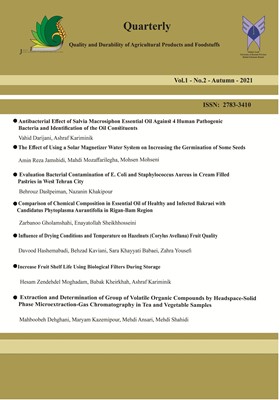Increase fruit shelf life using biological filters during storage
Subject Areas : Shelf Life of Food Products and Agricultural Productions
Ashraf Kariminik
1
![]() ,
Babak Kheirkhah
2
*
,
Babak Kheirkhah
2
*
![]() ,
Hesam Zendehdel Moghadam
3
,
Hesam Zendehdel Moghadam
3
![]()
1 - Assistant professor, Department of Microbiology, Kerman Branch, Islamic Azad University, Kerman, Iran
2 - Assistant professor, Department of Veterinary Medicine, Baft Branch, Islamic Azad University, Baft, Iran
3 - M.S, Department of Microbiology, Kerman Branch, Islamic Azad University, Kerman, Iran
Keywords: fruit, shelf life, Biological filter, Bacteria,
Abstract :
Any change in food that reduces its quality value or reduces its popularity and marketing is called food spoilage. Ethylene gas is one of the gases produced from ripe fruits that causes high ripening and spoilage of the fruit during storage. Solutions have been suggested to absorb this gas during fruit storage. The aim of this study was to apply bio-filters to remove ethylene gas to increase the life of banana fruit after harvest during storage. Various samples prepared from agricultural wastes containing natural environmental microorganisms were evaluated in biological filters designed to remove ethylene gas and prevent spoilage of banana fruit compared to control samples. The gas chromatograph showed that the amount of gas passing through column 4, which contained peat soil substrates, poplar wood chips, enriched organic substrate, leaf soil, straw and creamy organic fertilizer was equal to 0.6528 ml of ethylene per liter of air. It had the highest ability to remove ethylene gas compared to other columns and showed a significant difference with the control sample. In addition, this filter was observationally effective in terms of shelf life of immature bananas compared to control samples, and biological filters containing Pseudomonas putida have the highest amount of ethylene gas absorption. Based on the findings, the use of biological filters is recommended to increase the shelf life of fruits in storage.
1- Snyder AB, Worobo RW. The incidence and impact of microbial spoilage in the production of fruit and vegetable juices as reported by juice manufacturers. Food Co-ntrol. 2018;85:50-144.
2- Talaei A, Askari Sarcheshmeh M, Baha-doran F, Sharafatian D. Study of the effects of hot water treatments and polyethylene coating on storage life and pomegranate fruit quality. Iranian Agricultural Sciences. 2010;35(2):369-377.
3- Lincy J, Mathew G, Gurcharan S, Pra-bha M. Phytochemical investigation on va-rious parts of Psidium guajava. Annals of Plant Sciences. 2016;5(2):1265-1268.
4- Sedighi A, Gholami M, Sarikhani H, Ershadi A. Effect of salicylic acid and gibberellic acid on ripening time, anthoc-yanin content and ethylene production in black cherry fruit of Mashhad black culti-var. Journal of horticulture science. 2013; 26(2):141-146. [In Persian]
5- Rusca S, Charri`ere N, Droz PO, Oppli-ger A. Effects of bioaerosol exposure on work-related symptoms among Swiss saw-mill workers. International archives of occ-upational and environmental health. 2008; 81:415-421.
6- Babbitt CW, Pacheco A, Lindner AS. Methanol removal efficiency and bacterial diversity of an activated carbon biofilter. Bioresource technology. 2009;100(24): 16-6207.
7- Fu Y, Shao L, Liu H, Tong L, Liu H. Ethylene removal evaluation and bacterial community analysis of vermicompost as biofilter material. Journal of hazardous ma-terials. 2011;192(2): 66-658.
8- Fu Y, Shao L, Tong L, Liu H. Ethylene removal efficiency and bacterial commu-nity diversity of a natural zeolite biofilter. Bioresource technology. 2011;102(2):84-576.
9- Salehi, F. Effect of common and new gums on the quality, physical, and textural properties of bakery products: A review. Journal of Texture Studies. 2020;51 (2): 361-370.
10- Martınez-Romero D, Bailen G, Serrano M, Guillen F, Valverde JM, Zapata P, Castillo S, Valero D. Tools to maintain postharvest fruit and vegetable quality thr-ough the inhibition of ethylene action: a review. Critical reviews in food science and nutrition. 2007;47:543-560.
11- Badshah M, Parawira W, Mattiasson B. Anaerobic treatment of methanol cond-ensate from pulp mill compared with anaerobic treatment of methanol using me-sophilic UASB reactors. Bioresource tech-nology. 2012;125:318-327.
12- Jaiswal AK, Kumar S, Bhatnagar T. Studies to enhance the shelf life of tomato using Aloe vera and neem-based herbal coating. Australian Journal of Science and Technology. 2017;1(2):67-71.
13- Dukovski D, Bernatzky R, Han S. Flowering induction of Guzmania by eth-ylene. Scientia Horticulturae. 2006;110(1): 104-108.
14- Hosea ZY, Liamngee K, Owoicha Terna AL, Agatsa D. Effect of Neem leaf powder on postharvest shelf life and qua-lity of tomato fruits in storage. Internat-ional Journal of Development and Sustain-ability. 2017;6(10):1334-1349.
15- Elsgaard L. Ethylene removal by a biofilter with immobilized bacteria. Appli-ed and Environmental Microbiology. 1998; 64(11):73-4168.
16- Kim J, Hazard J. Assessment of ethy-lene removal with Pseudomonas strains. Journal of hazardous materials. 2006;131 (1-3):6-131.
17- Lee SH, Heber AJ. Ethylene removal using biofiltration. Part II. Parameter est-imation and mathematical modeling. Che-mical Engineering Journal. 2010;158 (2):89-99.
_||_
